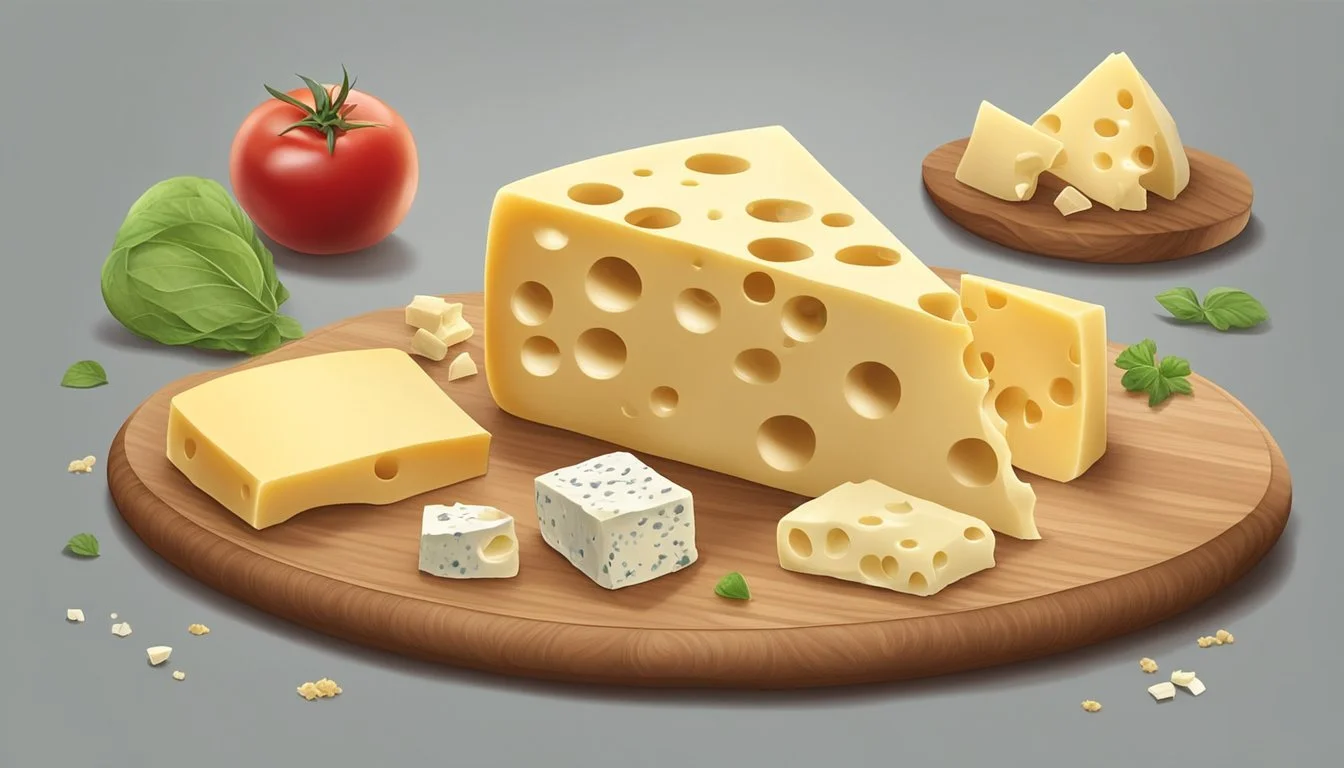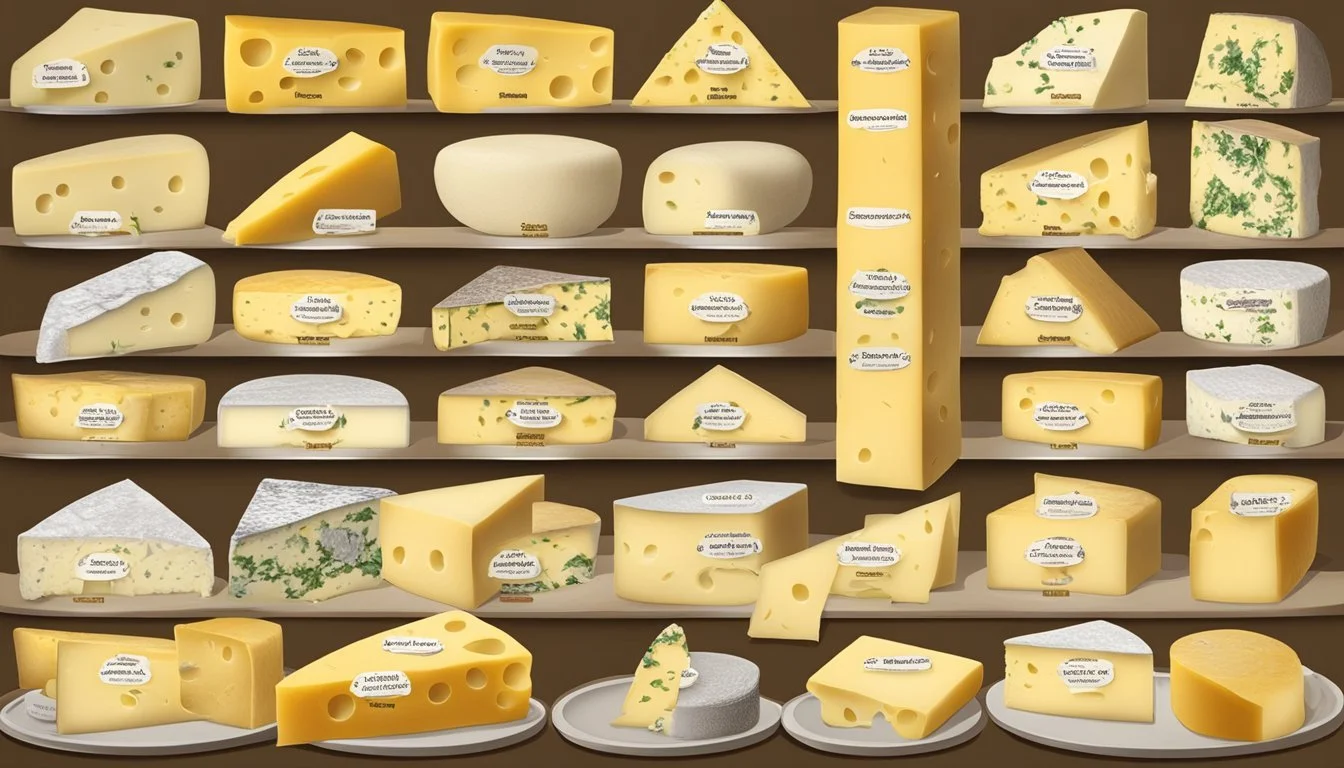Swiss Cheese Alternatives
Top Emmental Cheese Substitutes Explained
Swiss cheese, particularly Emmental, is renowned for its mild, nutty flavor and distinctive holes, known as "eyes," that develop during the fermentation process. Emmental cheese (What wine goes well with cheese?) originates from the Emme valley in Switzerland and is traditionally made from raw cow's milk. Its buttery taste with a hint of fruitiness makes it a staple in various dishes, including fondue, sandwiches (What wine goes well with sandwiches?), and quiches. However, due to its specific taste and texture, culinary enthusiasts may find themselves in need of a suitable substitute for Emmental cheese either due to availability issues or to suit different flavor profiles or dietary restrictions.
Cheese substitution is not merely a matter of swapping one type for another, but understanding the nuances that each variety brings to a dish. Gruyère cheese, for example, shares the Swiss origin and is a well-regarded alternative to Emmental. It melts effortlessly and brings a slightly stronger and earthier flavor, which can enhance savory recipes. Other options include Jarlsberg, which has a milder taste and a similar texture, and French Comté, with its complex flavors that resemble those of Gruyère. When looking for a substitute for Emmental, it's essential to consider how the cheese melts, its flavor profile, and how it complements the other ingredients in a recipe.
Although Swiss cheese and Emmental are sometimes used interchangeably in conversation, it's important to note that "Swiss cheese" as a category can include various types with similarities to Emmental. Each of these cheeses, while having their own distinctive qualities, can serve as a substitute in the absence of traditional Emmental, ensuring that dishes retain their intended flavor and texture profiles. When selecting an alternative, it's crucial for chefs and home cooks alike to consider the desired outcome of their recipes to make an informed choice that aligns with the original character of Emmental cheese.
Overview of Swiss Cheese
Swiss cheese is renowned for its distinctive holes and rich flavor, emblematic of the traditional methods employed in its creation.
Characteristics of Emmental Cheese
Emmental cheese, often recognized as the archetype of Swiss cheese, is known for its large, irregular holes and a mild, slightly nutty flavor. It has a smooth, yellowish body with a firm yet supple texture. This cheese is also characterized by its melting properties, making it a versatile component in various dishes. Its taste profile includes mild fruity notes, attributed to the fermentation process that develops over the aging period.
Production and Origin of Swiss Cheese
Swiss cheese production is intertwined with Switzerland's dairy-farming heritage. Traditionally, unpasteurized cow's milk is used to retain the full spectrum of milk flavors. The cheese-making process involves a specific fermentation process that creates carbon dioxide gas, forming the signature holes — a feature technically known as "eyes". Swiss Emmental originates from the Emme Valley, where historical records of cheese production date back to the early 13th century. These time-honored techniques ensure the continuation of quality and authenticity that is inherently Swiss.
Culinary Uses
Emmental cheese's sweet and mildly nutty flavor makes it a prime candidate for various culinary applications, particularly where melting qualities and subtle flavor enhancements are desired.
Swiss Cheese in Fondue and Casseroles
In the world of fondue and casseroles, Emmental plays a vital role. Its ability to melt smoothly without becoming greasy allows it to blend seamlessly with other ingredients. For cheese fondue, Emmental can be combined with Gruyère to create a rich, velvety texture, commonly seasoned with garlic, white wine, and a dash of nutmeg for a classical Swiss cheese fondue experience. In casseroles, Emmental's melting properties contribute to a comforting and cohesive dish, whether it be a traditional potato gratin or a vegetable bake.
Versatility in Sandwiches and Burgers
Emmental's versatility extends to sandwiches and burgers, where its sweet profile complements meats and pickled vegetables alike. For a grilled cheese sandwich, the cheese melts thoroughly, creating a gooey center with a perfectly toasted exterior. On burgers, Emmental can add a sophisticated twist, melting over the patty to provide a nutty layer that enhances the overall flavor profile without overwhelming the other ingredients.
Cheese Boards and Platters
To curate an enticing cheese board or platter, Emmental is a top pick. It balances the stronger flavors of aged cheeses and the creaminess of soft ones, ensuring a well-rounded selection. When serving, Emmental can be cubed or sliced and paired with fruits like grapes or figs, nuts, and a selection of cold cuts or dried meats, creating a harmonious blend of textures and tastes. It also serves as a milder counterpoint that won't overpower the flavors of accompanying wines or spirits.
Taste and Texture Profiles
In the quest for the perfect substitute for Swiss and Emmental cheeses, both the nuanced spectrum of flavors and the diversity of textures play pivotal roles. Choosing an alternative involves considering how closely it can mimic the delicate balance of taste and mouthfeel found in these classic cheeses.
Flavor Diversity
Swiss Cheese typically displays a mild flavor with a hint of nutty undertones. Emmental, a type of Swiss cheese, is known for its signature complexity and subtle sweetness. Alternatives like Gruyère share this nutty flavor, but can introduce a slightly stronger taste, with both salty and earthy dimensions adding to its profile.
Fontina: Offers a medium flavor, sometimes mild like traditional Swiss cheese.
Vacherin: Introduces a fruity note, maintaining the gentle essence.
Pecorino Romano: Presents a more pronounced saltiness, suitable for those who prefer a more robust palate.
Comparison of Textures
Both Swiss and Emmental cheeses are renowned for their smooth texture—it's integral to their appeal. Texture can range from semi-soft to hard, and ideal substitutes should offer a balance of creaminess without being too crumbly or dense.
Fontina: Manifests a semi-soft texture that is slightly hard, mirroring Swiss cheese's creamy texture.
Edam: Is less crumbly while still providing good melting capabilities, suitable for many dishes requiring a smooth texture.
Burrata: Although a fresh cheese, it comes with a delicate and creamy texture, making it an alternative for those not reliant on meltability.
Gruyère: Similar to Emmental, it offers a creamy-yet-firm texture that is versatile across culinary applications.
The right substitute will offer a balance of taste and texture that complements the dish it is used in, much like the original Swiss or Emmental cheese would.
Substitutes for Emmental Cheese
When seeking an alternative to Emmental cheese, it's important to consider flavor, texture, and melting properties. Various cheese varieties offer similar characteristics, while vegan and lactose-free substitutes also provide suitable options for different dietary needs.
Cheese Varieties as Alternatives
Gruyère: Known for its rich and nutty flavor, Gruyère cheese is often regarded as the closest substitute for Emmental. It provides a similar texture and excellent melting capability, making it suitable for fondues and baked dishes.
Fontina: With its creamy and slightly tangy notes, Italian Fontina cheese also mimics the meltability of Emmental, perfect for hot sandwiches and sauces.
Jarlsberg: This Norwegian cheese has a mild, nutty flavor similar to Emmental and is a fitting alternative in cold and hot dishes.
French Comté: Offering a complex, nutty taste, French Comté can replace Emmental in recipes requiring a depth of flavor.
Provolone: This semi-hard cheese provides a mild, slightly tangy taste and melts well, making it a versatile substitute.
Gouda: Aged Gouda cheese imparts a sweetness that resembles Emmental's flavor profile while melting smoothly.
Raclette: Although it's bolder, Raclette cheese shares the gooey melt that many enjoy in Emmental cheese dishes.
Other Cheeses: Cheddar, brie, Havarti, manchego cheese, and edam cheese can also substitute for Swiss cheese in specific contexts, adjusting for flavor and melting differences.
Vegan and Lactose-Free Substitutes
For those avoiding animal products or lactose, these alternatives maintain the essence of Emmental without compromising on dietary restrictions:
Vegan Cheddar: A variety of brands offer vegan cheddar which can mimic the melting characteristics of Emmental to an extent and offer a similar visual appeal in dishes.
Lactose-Free Swiss Cheese Alternatives: Some dairy brands create lactose-free versions of Swiss-style cheeses that retain the classic Emmental taste.
Using these substitutes, individuals can enjoy a range of dishes that typically feature Emmental, regardless of dietary preferences or restrictions.
Regional and International Varieties
When seeking alternatives to Emmental cheese, one encounters a diverse array of regional and international varieties. These substitutes offer similar textures and flavors, making them suitable for many of the same culinary applications.
Swiss Cheese Outside Switzerland
Swiss cheese, an umbrella term often used outside Switzerland, encompasses varieties like Gruyère and Raclette that boast a similar heritage to Emmental cheese. Notably, Gruyère is a Swiss cheese with a creamy, nutty flavor, ideal for melting in dishes such as fondue and French onion soup. Raclette, another melt-friendly cheese, shares Emmental's functionality in traditional Swiss dishes.
Gruyère: Complex, nutty flavor; perfect for melting.
Raclette: Creamy texture; used in traditional Swiss meals.
Worldwide Cheese Adaptations
Globally, cheeses like Jarlsberg from Norway and Fontina from Italy mimic the attributes of Swiss cheese varieties to some extent. Jarlsberg is known for its large holes and mild, sweet flavor, whereas Fontina offers a slightly hard texture and a rich, creamy taste, making it another commendable substitute.
Italian Varieties: Fontina; semi-soft, medium flavor, creamy.
French Cheeses: Comté, similar to Gruyère, presents a complex, fruity, and nutty profile; while Brie, being soft and creamy, differs significantly in texture but is still a cheese of note.
Manchego from Spain, and Edam from the Netherlands, offer their unique textures and tastes, though not as closely related, indicative of the regional adaptations of cheese around the world.
Various adaptations of cheese like mozzarella, cheddar, havarti, and manchego, while distinct, still fit into the global cheese landscape by offering alternative tastes and textures for different culinary uses:
Mozzarella Cheese (Italy): Soft, meltable, often used in pizzas.
Cheddar Cheese (Originating from England): Can vary from mild to extra sharp; also melts well, used in various cuisines.
Havarti Cheese (Denmark): Creamy and semi-soft; a convenient slicer for sandwiches.
Manchego (Spain): Firm texture with a distinctive flavor, not as meltable but provides a characteristic taste in cheese platters.
Pairing and Cooking Techniques
When substituting Emmental cheese in recipes, chefs and home cooks should consider how the cheese's melting properties and flavor profile will interact with other ingredients. The text that follows elucidates specific techniques for incorporating substitutes into hot dishes and cold preparations.
Cheese in Hot Dishes
Emmental cheese, adored for its superb melting qualities, traditionally graces hot dishes such as fondue, French onion soup, and raclette. When seeking substitutes for Emmental, one should opt for cheeses that share these melting properties. Gruyère, for instance, known for its creamy melt, is a prime choice for harmonious integration into baked dishes, gratins, and creamy sauces. Cooking techniques that benefit from these substitutes include:
Fondue: Utilize a substitute like Gruyère or Jarlsberg for a smooth, rich fondue.
Gratins: Layer potatoes or other vegetables with the cheese for a golden, bubbling crust.
Pasta: Add to sauces for dishes like macaroni and cheese for creaminess.
Grilled Cheese Sandwiches and Paninis: Choose a meltable substitute for a gooey, comforting filling.
Serving Cheese in Cold Preparations
On the other hand, a cheese board presents an opportunity to appreciate the nuanced flavors of Emmental and its counterparts without the influence of heat. Alternatives such as Jarlsberg or Fontina, which closely mimic the nutty taste of Emmental, are excellent choices for cold dishes. Their rich but milder flavors complement fruits making them ideal for caprese and bruschetta, or simply served on a cracker. For cold preparations, consider the following:
Cheese Board: Pair substitute cheeses with grapes, nuts, or fig jam for a balanced palate.
Caprese: Use slices in a classic caprese salad for a softer texture and mild taste.
Bruschetta: Top with thinly sliced alternatives and broil for a light melt, enhancing the dish without overwhelming it.
Nutritional Information
When discussing Emmental cheese substitutes, it's important to consider their nutritional profiles. Each cheese brings unique health benefits and dietary considerations, which are important for informed consumption.
Health Benefits
Emmental cheese, known for its nutty and mild flavor, provides an array of health benefits. It is a good source of calcium and protein, essential for bone health and muscle maintenance. It also contains vitamins such as Vitamin B12 and riboflavin, which support neurological function and energy metabolism.
Calcium: vital for bone health
Protein: supports muscle repair and growth
Vitamins B12 and Riboflavin: key for neurological health and converting food into energy
Dietary Considerations
When considering Emmental cheese in a diet, it's crucial to note its calorie content and fat composition. The cheese is calorie-dense and contains saturated fats, which should be consumed in moderation.
Calories: roughly 113 kcal per ounce
Total Fat: about 9g per ounce with 6g being saturated fat
People with dietary restrictions related to lactose intolerance or those managing cholesterol levels might need to seek alternatives or consume Emmental cheese in limited quantities. It's also relevant to note that many Emmental substitutes may share similar nutritional profiles, so substituting one for another may not significantly alter dietary intake.
Buying and Storing Tips
When selecting and storing Swiss cheese varieties like Emmental, one must consider both the origin of the cheese and the optimal storage conditions to maintain its quality and flavor.
Selection at Supermarkets
At the supermarket, consumers should look for Swiss cheese that has a pale yellow color and a smooth texture. Emmental cheese, a type of Swiss cheese, should possess characteristic large holes, known as "eyes," and a firm but slightly springy feel. The label should provide information on the origin and age of the cheese, which can be indicative of flavor depth and quality.
Look For:
Pale yellow color
Smooth texture with uniform eyes
Origin and age on the label
Preservation and Shelf Life
Proper preservation is key to extending the shelf life of Swiss cheese like Emmental. One should store the cheese in a refrigerator, ideally at temperatures between 35°F and 45°F (1.6°C and 7.2°C). Cheese should be wrapped in parchment paper followed by a wrap of aluminum foil or placed inside an airtight container to prevent it from drying out or absorbing other flavors and odors.
Storage Conditions:
Refrigerate at 35°F to 45°F
Wrap in parchment, then foil or use an airtight container
Emmental usually maintains good quality for three to four weeks when stored properly in the fridge. However, once sliced or cut from a larger block, its shelf life may lessen, and it's recommended to consume it within two weeks for optimal flavor and texture.







